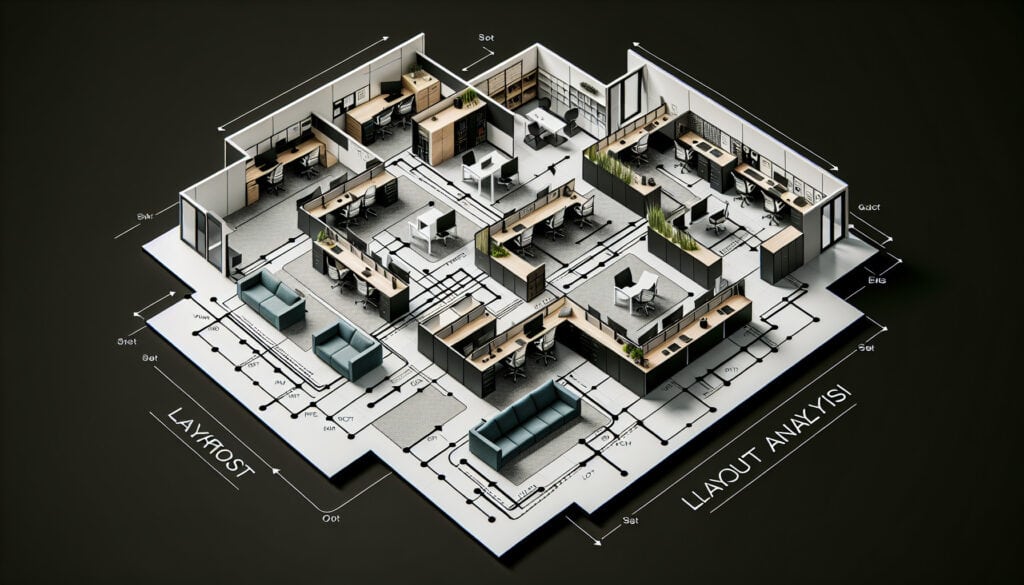To analyze and optimize the layout of a physical space.
- Methodologies: Customers & Marketing, Economics, Product Design
Layout Analysis

Layout Analysis
- Continuous Improvement, Design for Manufacturing (DfM), Efficiency, Ergonomics, Lean Manufacturing, Process Optimization, Productivity, Simulation
Objective:
How it’s used:
- The process of analyzing the layout of a physical space, such as a factory floor or an office, to improve efficiency, safety, and productivity. It often involves using tools like flow diagrams and simulation to model the movement of people and materials.
Pros
- Can improve efficiency and reduce costs; Can improve safety and ergonomics.
Cons
- Can be time-consuming and complex to perform; May require specialized software and expertise.
Categories:
- Ergonomics, Manufacturing
Best for:
- Optimizing the layout of a factory floor or an office to improve efficiency and safety.
Layout Analysis serves as a strategic approach in various industries, including manufacturing, warehousing, healthcare, and office environments, where optimizing spatial arrangements can lead to enhanced workflows and better resource utilization. In the context of a factory floor, this methodology is typically employed during the design or re-evaluation phase, where engineers and operations managers collaborate to assess current layouts using tools like process flow diagrams. By modeling the movement of materials and personnel, bottlenecks can be identified and addressed, decreasing cycle times and minimizing waste. In offices, layout analysis can be conducted to enhance collaboration and productivity by arranging workstations and meeting areas to promote effective communication among teams. Participants may include facility planners, ergonomics experts, and safety officers who work together to ensure the space meets both operational needs and workplace safety regulations. Hospitals often utilize layout analysis to optimize patient flow, reduce wait times, and enhance the overall care experience, which can lead to better health outcomes. Using simulation tools allows stakeholders to experiment with different configurations virtually, leading to data-driven decisions that can significantly decrease costs associated with downtime and safety incidents while improving employee morale through ergonomically friendly designs. Implementing effective layout analysis fosters an environment conducive to continuous improvement, contributing to long-term operational success.
Key steps of this methodology
- Identify critical workflows and processes within the space.
- Map current layout using flow diagrams to visualize movement patterns.
- Analyze circulation paths for efficiency, safety, and ergonomics.
- Identify bottlenecks or obstacles that impact workflow.
- Evaluate space utilization and storage efficiency.
- Engage simulation tools to model proposed layout changes.
- Test layout alternatives through simulations to assess impact.
- Refine layout options based on simulation outcomes and feedback.
- Implement the chosen layout with necessary modifications.
- Monitor performance metrics and adjust the layout as needed.
Pro Tips
- Integrate Lean principles by mapping value streams to eliminate waste and enhance workflow efficiency in layout design.
- Employ continuous simulation tools to assess dynamic interactions between workers and materials, optimizing movement pathways.
- Incorporate ergonomic evaluations into layout decisions, ensuring workstations support user health and safety while maximizing productivity.
To read and compare several methodologies, we recommend the
> Extensive Methodologies Repository <
together with the 400+ other methodologies.
Your comments on this methodology or additional info are welcome on the comment section below ↓ , so as any engineering-related ideas or links.
Historical Context
1949
1950
1950
1960
1960
1960
1960
1940
1950
1950
1958
1960
1960
1960
1960
(if date is unknown or not relevant, e.g. "fluid mechanics", a rounded estimation of its notable emergence is provided)















Related Posts
METS to Calories Calculator
Meta-Analysis
Message Mapping
Mental Model Diagrams
Maximum Acceptable Pushing and Pulling Forces
Material Requirements Planning (MRP)